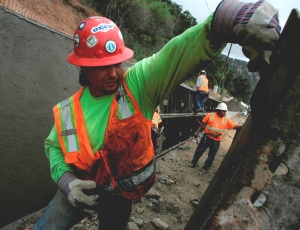Doing its part to get the Southern California economy moving, the Orange County Transportation Authority reports that it has advanced more than $525 million worth of projects into construction this year.

For every $1 billion spent on infrastructure improvements, it is estimated that 18,000 jobs are created. In Orange County, the investment translates into nearly 9,500 jobs for a region hit hard by the economic recession, OCTA says.
�Our goal is to get projects out on the street as quickly as possible to improve our transportation network and provide much-needed employment opportunities for the transportation and construction sectors,� says Will Kempton, CEO of OCTA.
OCTA says its shelf-ready projects made it eligible for matching dollars through state and federal sources and in the past year, OCTA has leveraged $600 million. Combined with Measure M, the county�s half-cent sales tax for transportation, OCTA was able to quickly advance projects into construction.
�These infrastructure projects provide the boost Orange County needs to get the economy on the right track,� says Lucy Dunn, president and CEO of the Orange County Business Council and member of the California Transportation Commission. �Orange County is ready to work and OCTA continues to be a major player in developing the jobs that will stimulate our local economy.�
By moving projects into construction, OCTA experienced a 40% savings in construction costs totaling more than $100 million.
�While the economic situation has been a challenge, the one positive byproduct is lower construction bids on projects,� says Kempton. �The savings we received allowed us to put even more projects out to bid, which created additional work for the private sector overall.�
Projects that started construction spanned the county:
� $165.5 million to add carpool connectors between three freeways, the Garden Grove Freeway (SR-22), San Diego Freeway (I-405) and San Gabriel Freeway (I-605)
� $95 million in infrastructure improvements for increased rail service
� $85 million to enhance safety at 50 railroad crossings
� $68.3 million to add a 5-mile northbound lane on the Orange Freeway (SR-57)
� $40 million to add an eastbound lane on the Riverside Freeway (SR-91) from the Eastern Toll Road (SR-241) to the Chino Valley Freeway (SR-71)
� $34.2 million for grade separation projects
� $28.7 million for various parking improvements
� $4.6 million to construct new soundwalls
� $3.9 million for improvements at bus bases
�OCTA has a proven track record of completing projects, which is why the voters of Orange County entrusted us with the renewal of Measure M in 2006,� says OCTA Chairman Jerry Amante. �As a self-help county, we have the advantage of using local dollars to attract outside funds while ensuring we are making the improvements that our residents see as a priority.�
Projects coming down the line as part of the Measure M2 program include $590 million for seven grade separation projects; $1.4 billion in improvements to the SR-91 (Riverside Freeway), one of the most heavily traveled stretches of highway in the nation; and $600 million to improve connections to Metrolink, Orange County�s backbone commuter-rail system.
�Orange County is part of a growing region and our approach to transportation planning includes a combination of increased transit options and improved infrastructure,� adds Amante. �Together, these projects will have a lasting impact on how residents and commuters travel around the county for years to come.�

Post a comment to this article
Report Abusive Comment